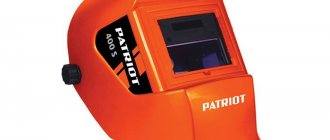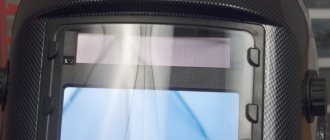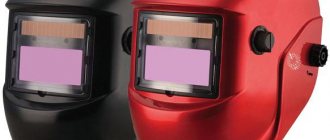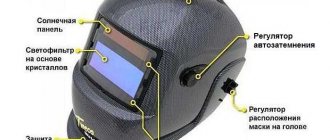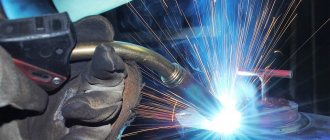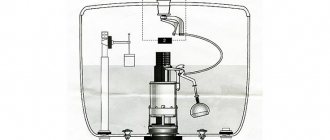Operating principle of the chameleon welding helmet
On the market you can find two types of shields, with a fixed degree of darkness and chameleon masks. Masks of the second type are distinguished by their higher cost and the presence of an automatic light filter that can respond to the intensity of light radiation, thereby protecting vision. The principle of operation of the chameleon welding mask is based on the fact that the light filter instantly reacts to light radiation and, depending on the intensity of the latter, automatically darkens the light radiation. The auto-darkening filter, in turn, has a layered structure in which layers of liquid crystals alternate with special films. At the moment the arc is ignited, the crystals are arranged in a certain order and do not allow part of the light to pass through.
chameleon welding helmet diagram
Based on this principle, you can effectively protect your eyesight from the influence of bright vision.
What types of welding helmets are there and how they differ
The most popular question among novice welders is the choice of personal protective equipment. And the main tool is a welding helmet, which is not so easy to choose if you do not know its main features, differences, characteristics and operating principle. First, let’s look at what types of PPE there are for a welder:
- Glasses differ from a mask not only in the external design, but also in the protection feature. If the mask protects the entire part of the face, then the glasses are intended solely to protect the eyes. They are usually used by experienced craftsmen when performing work in non-standard conditions, for example, at heights, when using a mask is impossible or inconvenient. Glasses for welders are of the open type, which are similar to ordinary ones, and are fixed behind the ear with arms. The glass in them is made of polycarbonate, and PPE is used as an auxiliary device. Closed glasses differ from open glasses by the presence of a special tape, with the help of which the product is securely fixed on the head. Devices of this type may have glass made of tinted glass, polycarbonate or Chameleon.
- A mask is the most common type of protective equipment for a welder. The main advantage of the product is the comprehensive protection of not only the welder’s face and neck from the adverse effects of welding work, but also the head. Masks can be simple (with tinted lenses), which are used extremely rarely today, as well as Chameleon. The correct name of the products is Chameleon - a protective welder's mask with an automatic darkening function. The product is fixed on the head using a special adjustment frame.
- Shield - Some welders continue to use another type of safety device. The shields have a flat base with built-in tinted glass at the top. A shield differs from a mask in that it does not protect the head as a whole, but only the front part. The shields are ordinary with tinted glass, which the welder needs to hold with one hand (shown in the photo).
Manufacturers produce Chameleon-type shields, but the demand for them is less than for welding helmets.
Masks are classified into subtypes depending on the presence of additional functionality. They come in the following types:
- With a lifting light filter - it differs from a regular mask in that the tinted glass is attached with a hinge joint and can be lowered or raised. Under the darkened glass there is a transparent glass through which the welder can control the welding process. Products of this kind are becoming less and less popular.
- With forced air supply - this type of mask requires special attention. The equipment is characterized by an increased degree of protection, and therefore its cost is correspondingly high. In addition to the light filter, the mask includes an air filtration system, preventing harmful substances from entering the welder’s respiratory system. The system is represented by an air blower, through which not only fresh air is supplied to the face, but also cool air, eliminating heat stroke. Through the return valve, carbon dioxide is removed to the outside. The blower operates using batteries. Typically, these types of devices are equipped with more powerful lithium-ion rechargeable batteries.
Naturally, a beginner who sets out to buy a welding helmet needs to choose devices from the Chameleon type mask category. Not only do they provide maximum protection, but they are also easy to use.
Existing faults. Do-it-yourself chameleon welding helmet repair
Let's look at the question of why the shield may not work. Let's look at typical welding helmet malfunctions. It often happens that a chameleon welding mask does not perform its main function, namely, it does not reduce the level of light radiation. The essence of the problem may lie in dead batteries. The chameleon welding helmet can be powered by both regular AAA batteries and a solar panel located on the body. Simply put, replacing the battery can solve the problem. If we consider the first method of powering the shield with energy, then simply insert the batteries into it. If powered by a battery, you need to hold the shield under a bright light to charge it.
But even after this procedure, you may find that the shield still does not work. The reason may be the protective glass. Typically, with this type of malfunction, cracks, chips and other mechanical damage are visible on the glass. In this case, it is necessary to replace the liquid crystal glass, which is the most expensive component in the mask. It is important to remember that the new glass must fully comply with the previous one in all respects.
The filter may blink. Here the protective glass may be either simply dirty or damaged. In this case, it is better to immediately change the filter with protective glass.
It is better not to repair the light filter of a welding helmet yourself. It would be better to contact specialists at a service center. This will cost money, but the service center can accurately identify the cause of the breakdown and specialists will easily fix it.
Poor visibility does not have a beneficial effect on vision, so it is important to properly secure the headband, install a good lighting source in the workplace, remove the film from the protective glass, and adjust the degree of darkness. At low temperatures, there may be a delay in dimming. Do not use the mask at temperatures below - 10 degrees Celsius.
Replacing batteries in the Chameleon mask
Unfortunately, the CR2032 battery did not last long. Despite the fact that current consumption is measured in microamps, after some time the filter did not work again.
Of course, a question like “What should I do?” didn't even arise. It was necessary to install a more powerful power source. The most suitable option is two 1.5V elements of size AA or AAA. They can be placed in a special battery compartment, which is commercially available. I didn’t have one, so I had to saw off the battery compartment from my favorite TV remote control.
I sawed off the part where the contacts for the batteries are located from the printed circuit board. I cleaned everything unnecessary (microcircuit and wiring) and soldered two stranded wires to the contacts. The end was lightly covered with what was at hand. It turned out to be a good battery compartment for two AA elements.
The battery compartment is attached to the mask with two M2.5 bolts. The holes are drilled in the center, so the mount does not interfere with the installation of batteries in the compartment. Can be mounted anywhere. The wires should be as short as possible. I secured the compartment at the top, above my head. In this case, the overall balancing is not disturbed, and there is free access to the compartment for replacing batteries. During idle periods, you can even remove one battery from the compartment. For the purpose of, so to speak, global economy.
How to properly set up a chameleon mask for welding? What do you need to remember when working?
In order to know how to set up the mask and how to check its performance, it is better to refer to the operating instructions. Important to remember:
- the chameleon mask is not suitable for plasma and gas welding and cutting;
- Do not leave the shield on a hot surface;
- It is better not to disassemble the filter cartridge;
- the shield will not withstand strong impacts;
- Changes cannot be made to the filter. It is allowed to use spare parts specified in the instructions;
- if the chameleon welding helmet does not darken the image, you need to stop working and identify the possible cause of the malfunction;
- it is necessary to prevent moisture from entering the light filter;
- When cleaning the shield, it is not recommended to use detergents and solvents;
- the headband for putting on can cause an allergic reaction, the straps must be adjusted correctly to prevent skin irritation;
- In order to change the batteries, switch the shield to grinding mode. When the red light on the filter lights up, you need to replace the batteries;
- Before starting work, you need to adjust the mask to suit yourself to achieve maximum comfort. You can select the darkness level, delay time and sensitivity level.
Regulators in the design of masks or how to properly configure the device for operation
Chameleon welding masks are equipped with regulators, through which you can change device parameters depending on operating conditions. Depending on the model, the design provides the following adjustment options:
- Darkening is the main type of adjustment that is present on almost all Chameleon masks. The dimming adjustment range is measured in DIN, and the maximum value is 12-13 DIN and the minimum is 3-4 DIN. Below is a table of the dependence of the amount of darkening on the strength of the welding current.
Darkening table for DIN filters (depending on current strength and type of welding) - Sensitivity - designed to increase or decrease the threshold of the filter. Depends on operating conditions (during the daytime in good lighting or indoors).
- Delay time (return from dark to light) - eliminates the possibility of premature opening of the mask and getting “welding bunnies”.
- Disabling the filter is an additional function that is designed to operate the mask when working with an angle grinder (grinder) in stripping or grinding mode.
Having dealt with the basic functionality of welding helmets, let’s move on to the question of how to configure them correctly. Many beginners and others are faced with the fact that after purchasing a mask (especially when ordering it online), they have difficulty setting it up. To perform adjustments, the design provides special regulators, the number and location of which differs depending on the model and manufacturer of the equipment. It is especially difficult to understand the settings if the device does not come with instructions or if they are presented in a foreign language.
Let’s look at how to set up a welding helmet yourself, step by step with photos and detailed descriptions. To begin with, it is worth noting that all Chameleon-type protective equipment with existing regulators requires adjustment manipulations. The setup process is performed as follows:
- The first regulator in the form of a push-button switch called MODE is designed to select the appropriate operating mode depending on the value of the welding current. The “Grid” mode is activated when performing cleaning work with an angle grinder. When you turn on the “4-8” mode, the average degree of darkening is set, which corresponds to the operation of welding equipment with currents up to 30 A. The “9-13” mode is activated when working with currents from 60 to 350 Amps. It is the latter mode that is used most often when working with modern welding machines.
- The second wheel-shaped control called “Shade” is responsible for more precise dimming adjustment. Along the perimeter of the regulator there are digital symbols that correspond to the set range for the first regulator. If the “4-8” mode is turned on, then the regulator can set a more precise value - 4, 5, 6, 7 and 8 DIN (in parentheses). Likewise when you turn on the “9-13” mode. The degree of darkness depends not only on the current strength, but also on the visibility of the picture. With the correct degree of darkness set, the welder should see not only the arc, but also the heat-affected part with an area up to 1-2 cm in size.
- The next control is called “Delay”. It is responsible for delaying the filter to clarify. It is important to understand what types of metals are being welded. If these are heavy metals, welding of which is carried out with a high current, then the Delay regulator should be switched to an increased delay time mode. This is necessary so that after the arc disappears, the light filter does not work prematurely (and at the same time blind the person) when the metal at the welding site has not yet cooled down. It is at such moments that a negative impact on the welder’s vision occurs, so it is very important to set the delay as accurately as possible. If the adjustment range is not numbered, then you need to focus on the following delay values - the minimum is 0.2-0.3 seconds, and the maximum is 1-2 seconds.
- The regulator called Sensitivity is responsible for sensitivity. Depends on the operating conditions of the welding equipment. This may be in an open area in clear weather with bright sunshine, or indoor work in low light. If work is carried out outdoors in sunny weather, then the regulator is moved to the low sensitivity position, that is, Low. If the room is in low light, then you need to move the regulator to the other side High (maximum sensitivity).
The number and location of regulators on welding helmets of different manufacturers and models differs, but in most cases English names are used, so it will not be difficult to understand the purpose of the adjustment devices based on the instructions described above. The video below describes in detail what the regulators are responsible for and how to properly set up a Chinese welding helmet for operation.
Masks from the Russian manufacturer Resant use Russian names, so there are no difficulties with their adjustment. The video below shows how to correctly set up the Resanta MS-3 welding helmet.
Chameleon masks must be adjusted regularly before each use. This is especially true when the type of welding equipment, current strength, as well as weather conditions and the location of the manipulations change. A correctly configured Chameleon welding helmet is the key to not only saving vision, but also increasing comfort when carrying out welding work.
Carrying out maintenance
In order to reduce the likelihood of breakdown to zero, it is necessary to carry out maintenance from time to time. The minimum interval between repairs should be one month. To remove dirt and dust, you can use a cotton cloth pre-moistened with a non-aggressive liquid. Do not use oil-containing cleaning agents or abrasive materials as this may damage the protective shield. All cleaning actions must be carried out carefully; do not put too much pressure on the material.
Types of adjustments for chameleon welding helmets
There are several types of adjustments in a welding helmet. Before starting work, it is extremely important to configure all the characteristics. This is necessary for the most effective use of the mask when working. The following are the types of adjustments.
Preparation under the head
It is extremely important to securely fix the shield on your head. The diameter of the headband can be adjusted using a handle located on the back of the head. The procedure must be carried out with a shield on the head, which will allow you to obtain the necessary tension. If the headband sits high or low, it should be adjusted using a belt passing through the top of the head. Before starting work, check the fit of the shield. If it does not sit securely, you need to readjust it.
Adjusting the distance from the eyes to the filter
The mask can be moved away from the eyes and brought closer to the eyes by loosening the locking nuts. The distance from both eyes and the filter should be equal. If everything is done correctly, the locking nuts should be tightened.
Adjusting the darkness level
Depending on the type of welding and the current value, you can select the required degree of darkening from the table. This can also be done during operation using the regulator, which is located on the outside of the shield.
Adjusting sensitivity
There are two types of sensitivity: high and low. For most cases, you can set the control knob to the middle position. When working in TIG mode at low current values, maximum sensitivity is required. For optimal settings, it is better to set the sensitivity to maximum, and then reduce it until the filter begins to perceive light radiation only from the welding arc, and not from external light sources (the sun, lighting lamps, etc.). The required degree of sensitivity can also be selected according to a scheme where each type of welding has its own level of sensitivity.
Problems with the Chameleon mask
There is the following problem: when argon arc welding at 60...80A of steel strips, previously cleaned with an angle grinder, the Korund ASF 4/9-13 mask turns off for a tenth of a second. This happens rarely and most often when passing seams inside corners. Nevertheless, I manage to catch the “rabbits”, then, naturally, my eyes turn red and pain appears. Question: is the problem with the mask or is it my “crooked little hands” that are to blame?
Naturally, it is impossible to give a definite answer to this question. But there are several recommendations, because Chinese chameleon masks have been sold for several days and a lot of experience has been accumulated in their use. Take more interest from fellow welders.
Read the article on the website: Repairing a chameleon mask with your own hands
- Option number one: the optical sensor “does not see” the arc when welding in hard-to-reach places (or you cover the photocell with your hand). Adjust the sensitivity using the tuning knob. If it doesn't help, try using a regular filter. If you don’t want to burden yourself with selecting a light filter when welding at low/high currents, look for a mask with an electromagnetic arc sensor. Even such good PPE as Speedglas opens if you cook it “around the corner.”
- Option number two: the dimming is very slow, set the adjustment knob to maximum.
- The problem may also be this: simple cheap masks behave quite correctly when working with conventional inverters (without a set of “cool” welding functions). But as soon as you switch to professional equipment with the function of smooth ignition and arc extinction at a predetermined time, problems begin to appear. When ignited, the mask works normally, but after a while, when the arc flares up more strongly, subsecond shutdowns occur. This can be explained this way: the electronics adjust to the brightness of the light flux once, and then, when its intensity increases, it does not work a second time, because it is not adapted to such changes.
Add a comment Cancel reply
You must be logged in to post a comment.
Is it worth BUYING, reviews from welders:
